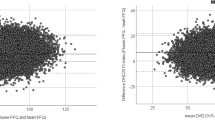Abstract
Objective: To determine and describe the extent to which European dietary data collected in disparate surveys can be meaningfully compared.
Design: Seven independent population-based surveys from six European countries were initially included. Differences in study designs and methodological approaches were examined. Risk factor data for 31, 289 adults aged 40–59 y were harmonized and pooled in a common, centralized database.
Results: Direct comparisons of dietary measures across studies were not deemed appropriate due to methodological heterogeneity. Nonetheless, comparisons of intra-population contrasts by gender across sites were considered valid. Women consumed fruit and vegetables more often than men. Age-standardized gender differences in the prevalence of low fruit and vegetable consumption ranged from 7 to 18% and 5 to 15%, respectively. Data on energy intake showed good agreement across study populations. The proportion of total energy from macronutrients was similar for women and men. Gender differences for relative intakes of saturated fatty acids (percentage energy) were small and only in France were they significant. Dietary fibre density was significantly higher in women than in men. Overall, the participating Southern European populations from Italy and Spain exhibited more healthful food composition patterns.
Conclusions: Contrasts in dietary patterns by gender across populations may provide the basis for health promotion campaigns. The most favourable patterns observed may serve as attainable goals for other populations. An international risk factor surveillance programme based upon locally run, good quality studies has the potential to provide the needed data.
Sponsorship: European Community (DG V), project 96CVVF3-446-0; Swiss Federal Office for Education and Science, OFES 96.0089.
European Journal of Clinical Nutrition (2000) 54, 253–262
This is a preview of subscription content, access via your institution
Access options
Subscribe to this journal
Receive 12 print issues and online access
$259.00 per year
only $21.58 per issue
Buy this article
- Purchase on Springer Link
- Instant access to full article PDF
Prices may be subject to local taxes which are calculated during checkout
Similar content being viewed by others
Author information
Authors and Affiliations
Contributions
Guarantors: A Morabia, EURALIM Project Director; and S Hercberg, EURALIM Project Co-ordinator. Together they constitute the EURALIM Steering Committee.
Contributors: The authors are listed according to a convention agreed upon by the ERUALIM study group. The first three contributors (the project manager, co-ordinator and director, respectively) prepared the first draft of the manuscript. The other contributors represent the principal investigator and one key investigator from each of the participating surveys (listed in alphabetical order), plus an external observer from the US.Involvement in project development and management, data preparation and analysis, and manuscript preparation qualify each contributor for authorship.
Corresponding author
Rights and permissions
About this article
Cite this article
Beer-Borst, S., Hercberg, S., Morabia, A. et al. Dietary patterns in six European populations: results from EURALIM, a collaborative European data harmonization and information campaign. Eur J Clin Nutr 54, 253–262 (2000). https://doi.org/10.1038/sj.ejcn.1600934
Received:
Revised:
Accepted:
Published:
Issue Date:
DOI: https://doi.org/10.1038/sj.ejcn.1600934
Keywords
This article is cited by
-
Mobile health application for Thai women: investigation and model
BMC Medical Informatics and Decision Making (2022)
-
Sex disparities in dietary intake across the lifespan: the case of Lebanon
Nutrition Journal (2020)
-
Legume and nut consumption in relation to depression, anxiety and psychological distress in Iranian adults
European Journal of Nutrition (2020)
-
The association of whole and refined grains consumption with psychological disorders among Iranian adults
European Journal of Nutrition (2019)
-
Link of dietary patterns with metabolic syndrome: analysis of the National Health and Nutrition Examination Survey
Nutrition & Diabetes (2017)



